Toyota Sienna Service Manual: Oxygen (A/F) Sensor Heater Control Circuit Low/ Oxygen (A/F) Sensor Heater Control Circuit High
DTC P0031 Oxygen (A/F) Sensor Heater Control Circuit Low (Bank 1 Sensor 1)
DTC P0032 Oxygen (A/F) Sensor Heater Control Circuit High (Bank 1 Sensor 1)
DTC P0051 Oxygen (A/F) Sensor Heater Control Circuit Low (Bank 2 Sensor 1)
DTC P0052 Oxygen (A/F) Sensor Heater Control Circuit High (Bank 2 Sensor 1)
HINT:
- Although the DTC titles say the oxygen sensor, these DTCs relate to the Air-Fuel Ratio (A/F) sensor.
- Sensor 1 refers to the sensor mounted in front of the Three-Way Catalytic Converter (TWC) and located near the engine assembly.
DESCRIPTION
Refer to DTC P2195.
HINT:
- When any of these DTCs are set, the ECM enters fail-safe mode. The ECM turns off the A/F sensor heater in fail-safe mode. Fail-safe mode continues until the ignition switch is turned off.
- The ECM provides a pulse width modulated control circuit to adjust the current through the heater. The A/F sensor heater circuit uses a relay on the +B side of the circuit.
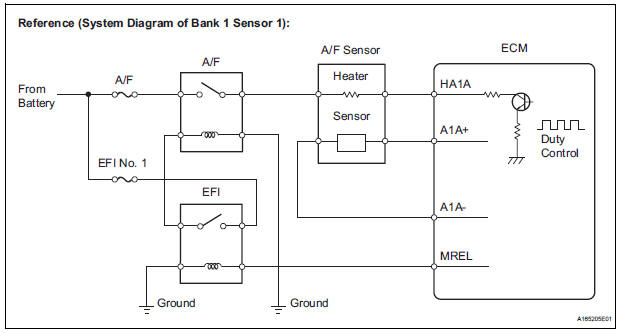
|
DTC No. |
DTC Detection Condition |
Trouble Area |
|
P0031 |
Air-Fuel Ratio (A/F) sensor heater current less than 0.8 A (1 trip detection logic) |
|
|
P0032 |
Air-Fuel Ratio (A/F) sensor heater current more than 10 A (1 trip detection logic) |
|
HINT:
- Bank 1 refers to the bank that includes cylinder No. 1.
- Bank 2 refers to the bank that does not include cylinder No. 1.
- Sensor 1 refers to the closest sensor to the engine assembly.
- Sensor 2 refers to the furthest sensor away from the engine assembly.
MONITOR DESCRIPTION
The ECM uses information from the Air-Fuel Ratio (A/F) sensor to regulate the air-fuel ratio and keep it close to the stoichiometric level. This maximizes the ability of the Three-Way Catalytic Converter (TWC) to purify the exhaust gas.
The A/F sensor detects oxygen levels in the exhaust gas and transmits the information to the ECM. The inner surface of the sensor element is exposed to the outside air. The outer surface of the sensor element is exposed to the exhaust gas. The sensor element is made of platinum coated zirconia and includes an integrated heating element.
The zirconia element generates small voltage when there is a large difference in the oxygen concentrations between the exhaust gas and outside air. The platinum coating amplifies this voltage generation.
The A/F sensor is more efficient when heated. When the exhaust gas temperature is low, the sensor cannot generate useful voltage signals without supplementary heating. The ECM regulates the supplementary heating using a duty-cycle approach to adjust the average current in the sensor heater element. If the heater current is outside the normal range, the signal transmitted by the A/F sensor will be inaccurate, as a result, the ECM will be unable to regulate air-fuel ratio properly.
When the current in the A/F sensor heater is outside the normal operating range, the ECM interprets this as a malfunction in the sensor heater and sets a DTC.
Example: The ECM sets DTC P0032 or P0052 when the current in the A/F sensor heater is more than 10 A.
Conversely, when the heater current is less than 0.8 A, DTC P0031 or P0051 is set.
MONITOR STRATEGY

TYPICAL ENABLING CONDITIONS
All:

P0031 and P0051:


P0032 and P0052:

TYPICAL MALFUNCTION THRESHOLDS
P0031 and P0051:

P0032 and P0052:

COMPONENT OPERATING RANGE

MONITOR RESULT
Refer to CHECKING MONITOR STATUS.
WIRING DIAGRAM
Refer to DTC P2195.
INSPECTION PROCEDURE
HINT: Read freeze frame data using the intelligent tester. The ECM records vehicle and driving condition information as freeze frame data the moment a DTC is stored. When troubleshooting, freeze frame data can be helpful in determining whether the vehicle was running or stopped, whether the engine was warmed up or not, whether the air-fuel ratio was lean or rich, as well as other data recorded at the time of a malfunction.
1 INSPECT AIR FUEL RATIO SENSOR (HEATER RESISTANCE)
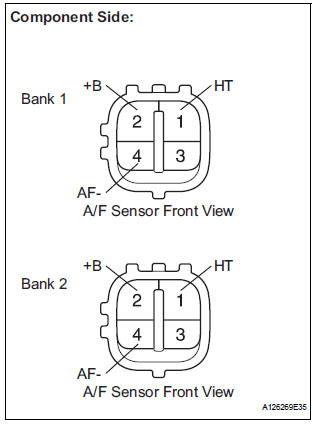
- Disconnect the A5 or A6 A/F sensor connector.
- Measure the resistance according to the value(s) in the table below.
Standard resistance: Bank 1

Bank 2

- Reconnect the A/F sensor connector.
Result

2 CHECK TERMINAL VOLTAGE (+B OF A/F SENSOR)
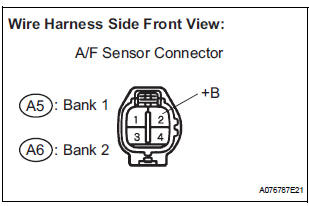
- Disconnect the A5 or A6 A/F sensor connector.
- Turn the ignition switch to the ON position.
- Measure the voltage according to the value(s) in the table below.
Standard voltage

- Reconnect the A/F sensor connector
3 INSPECT FUSE (A/F FUSE)
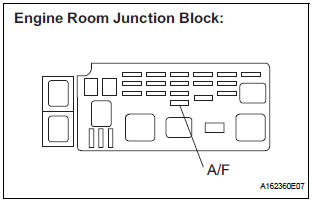
- Remove the A/F fuse from the engine room junction block.
- Measure the resistance according to the value(s) in the
table below.
Standard resistance: Below 1 Ω
- Reinstall the A/F fuse
4 INSPECT RELAY (A/F RELAY)
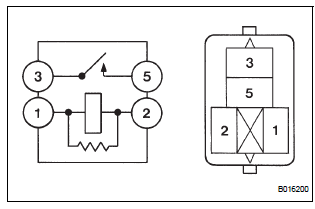
- Remove the A/F relay from the No. 6 engine room relay block.
- Measure the resistance according to the value(s) in the table below.
Standard resistance

- Reinstall the A/F relay.
5 CHECK HARNESS AND CONNECTOR (A/F SENSOR - A/F RELAY)
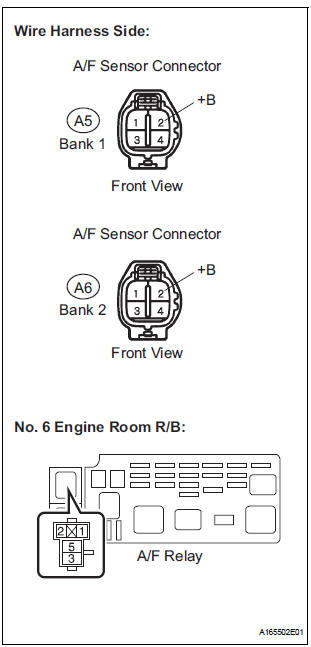
- Disconnect the A5 or A6 A/F sensor connector.
- Remove the A/F relay from the No. 6 engine room relay block.
- Measure the resistance according to the value(s) in the table below.
Standard resistance: Check for open

Check for short

- Reinstall the A/F relay.
- Reconnect the A/F sensor connector
6 CHECK HARNESS AND CONNECTOR (A/F RELAY - BODY GROUND)
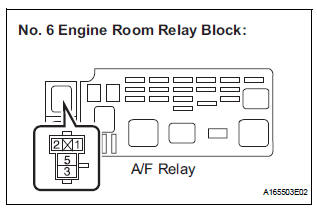
- Remove the A/F relay from the No. 6 engine room relay block.
- Measure the resistance according to the value(s) in the table below.
Standard resistance: Check for open

REPAIR OR REPLACE HARNESS OR CONNECTOR (A/F RELAY - BATTERY)
7 CHECK HARNESS AND CONNECTOR (A/F RELAY - ECM)
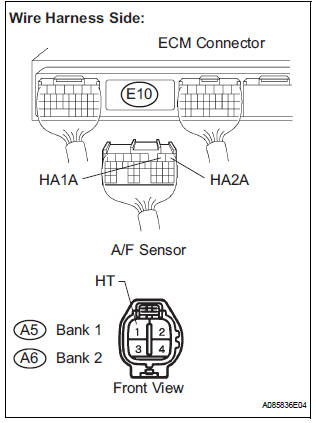
- Disconnect the A5 or A6 A/F sensor connector.
- Disconnect the E10 ECM connector.
- Measure the resistance according to the value(s) in the table below.
Standard resistance: Check for open

Check for short

- Reconnect the ECM connector.
- Reconnect the A/F sensor connectors.
8 CHECK WHETHER DTC OUTPUT RECURS
- Connect the intelligent tester to the DLC3.
- Turn the ignition switch to the ON position.
- Turn the intelligent tester ON.
- Clear the DTCs.
- Start the engine.
- Allow the engine to idle for 1 minute or more.
- Select the following menu items: DIAGNOSIS / ENHANCED OBD II / DTC INFO / CURRENT CODES.
- Read the DTCs.
Result

CHECK FOR INTERMITTENT PROBLEMS
 Crankshaft Position - Camshaft Position Correlation
Crankshaft Position - Camshaft Position Correlation
DTC P0016 Crankshaft Position - Camshaft Position Correlation
(Bank 1 Sensor A)
DTC P0017 Crankshaft Position - Camshaft Position Correlation
(Bank 1 Sensor B)
DTC P0018 Crankshaft Position - Cams ...
 Oxygen Sensor Heater Control Circuit Low/ Oxygen Sensor Heater Control
Circuit High/ Oxygen Sensor Heater Circuit Malfunction
Oxygen Sensor Heater Control Circuit Low/ Oxygen Sensor Heater Control
Circuit High/ Oxygen Sensor Heater Circuit Malfunction
DTC P0037 Oxygen Sensor Heater Control Circuit Low
(Bank 1 Sensor 2)
DTC P0038 Oxygen Sensor Heater Control Circuit High
(Bank 1 Sensor 2)
DTC P0057 Oxygen Sensor Heater Control Circuit Low
(Bank ...
Other materials:
Transfer
SERVICE DATA
TORQUE SPECIFICATIONS
PROPELLER SHAFT
SERVICE DATA
TORQUE SPECIFICATIONS
DRIVE SHAFT
SERVICE DATA
TORQUE SPECIFICATIONS
DIFFERENTIAL
SERVICE DATA
TORQUE SPECIFICATIONS
AXLE
SERVICE DATA
TORQUE SPECIFICATIONS
...
Diagnostic trouble code chart
If a malfunction code is displayed during the DTC check,
check the circuit listed for that code in the table below.
(Proceed to the page given for that circuit.)
BACK DOOR CLOSER SYSTEM
DTC No.
Detection Item
Trouble Area
B2215
Back Door Closer Switch
...
Installation
1. INSTALL HEATED OXYGEN SENSOR (for Bank 2
Sensor 2)
(a) Using SST, install the heated oxygen sensor to the
front exhaust pipe.
SST 09224-00010
Torque: 40 N*m (408 kgf*cm, 30 ft.*lbf) for use
with SST
44 N*m (449 kgf*cm, 32 ft.*lbf) for use
without SST
HINT:
Use a torque wrench wit ...
